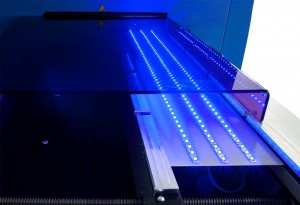Longboard Inspection: Oversize AOI
 Despite the wide variety of applications, certain panel sizes have proven to be particularly viable in the manufacturing process of electronic assemblies. On the one hand, this is due to the capacities for handling the panels inside the production machines, such as solder paste printers, pick and place machines, ovens, AOI, magazine stations. On the other hand, ergonomics plays an important role when the panels are handled by operating personnel, as well as the weight of the assemblies.
Despite the wide variety of applications, certain panel sizes have proven to be particularly viable in the manufacturing process of electronic assemblies. On the one hand, this is due to the capacities for handling the panels inside the production machines, such as solder paste printers, pick and place machines, ovens, AOI, magazine stations. On the other hand, ergonomics plays an important role when the panels are handled by operating personnel, as well as the weight of the assemblies.
The dimensions of the panels depend primarily on the respective application. As a rule, the edge lengths of individual assemblies are less than half a metre. Assemblies that are significantly smaller are generally produced on a multiplier. This results in increased throughput and optimal utilization of the machines in production. However, larger assemblies are more problematic. Most standard systems can no longer process these oversized assemblies.
What is the reason for large printed circuit boards?
Despite the trend towards miniaturization and integration in electronics, applications with particularly large individual assemblies
continue to arise. Lighting technology is one example: Current developments in LED technology can now be found in all types of
lighting, with increased luminous fluxes, generation of different colours, improved efficiency and production in a wide range of
shapes. In contrast to other electronic assemblies, size is often more important than miniaturization where the production
of lights is concerned. There are significant advantages when a larger LED light is produced on a single carrier, rather than assembling
it from individual components: The elimination of expensive and error-prone connectors and cables, a reduction in the
installation and service effort required, the integration of heat management, as well as an increase in the service life of the product.
An automatic optical inspection system (AOI) is indispensable for the efficient and automated production of assemblies. It is
primarily used for quality assurance, but also for the quick and reproducible detection of production faults. In addition to standard tests for the presence of components and an assessment of solder joints, these can also include distance and position measurements (e.g. the distance of a QFN to a register mark), a swash circumference test of connector pins, or to take a more exotic example, the alignment of reed contacts in their glass bodies.
AOI and automatic contacting even make it possible to extend the test of a lighting assembly to include the functional testing of LEDs, detection of micro cracks in the LED bodies, or even brightness and radiation measurements. AOI is also an important element for achieving complete traceability of assemblies, as well as for the immediate statistical evaluation of the errors and measured values determined. The large amount of data collected is structured according to any specifications required and exchanged with a production control system (MES interface).
This system can then intervene immediately in the upstream production, based on the information obtained. If a manufacturer is tasked with the production of an extra-long assembly, this may mean that series production using an automated line is impossible, and production steps must be carried out manually. Alternatively, an assembly line with special machinery can be set up exclusively for these products. The latter option is usually considerably more expensive, making it barely profitable for small and mediumsized series production. Ideally, production machines can be set up for this special task using simple retooling measures.There are a large number of AOI system providers world-wide. Most of the manufacturers naturally focus on the standard, widely-used applications in order to achieve high sales volumes and low machine prices.